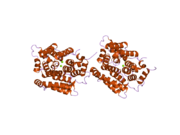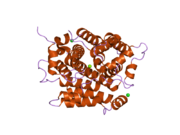From Wikipedia, the free encyclopedia
Protein-coding gene in the species Homo sapiens
(ADP-ribosyl)hydrolase 3 (ARH3) is an enzyme that in humans is encoded by the ADPRHL2 gene (also called ADPRS [ 5] [ 6] [ 7] [ 8] [ 9] [ 10] O -acetyl-ADP-ribose and alpha-NAD+ [ 10] [ 11] [ 12] [ 7] [ 13]
Loss-of-function mutations in the ADPRHL2 gene result in a recently defined disorder called stress-induced childhood-onset neurodegeneration with variable ataxia and seizures (CONDSIAS; OMIM: 618170).[ 14] [ 15] [ 16] [ 17] [ 18] [ 19] ophthalmoplegia , dysarthria, muscle weakness, axonal neuropathy, dysmetria, and tongue fasciculation.[ 16] [ 14] [ 15]
^ a b c GRCh38: Ensembl release 89: ENSG00000116863 – Ensembl , May 2017^ a b c GRCm38: Ensembl release 89: ENSMUSG00000042558 – Ensembl , May 2017^ "Human PubMed Reference:" . National Center for Biotechnology Information, U.S. National Library of Medicine .^ "Mouse PubMed Reference:" . National Center for Biotechnology Information, U.S. National Library of Medicine .^ "Gene symbol report | HUGO Gene Nomenclature Committee" .^ Glowacki G, Braren R, Firner K, Nissen M, Kühl M, Reche P, et al. (July 2002). "The family of toxin-related ecto-ADP-ribosyltransferases in humans and the mouse" . Protein Science . 11 (7): 1657–70. doi :10.1110/ps.0200602 . PMC 2373659 PMID 12070318 . ^ a b Oka S, Kato J, Moss J (January 2006). "Identification and characterization of a mammalian 39-kDa poly(ADP-ribose) glycohydrolase" . The Journal of Biological Chemistry . 281 (2): 705–13. doi :10.1074/jbc.M510290200 PMID 16278211 . ^ "Entrez Gene: ADPRHL2 ADP-ribosylhydrolase like 2" .^ Fontana P, Bonfiglio JJ, Palazzo L, Bartlett E, Matic I, Ahel I (June 2017). "Serine ADP-ribosylation reversal by the hydrolase ARH3" . eLife . 6 . doi :10.7554/eLife.28533 PMC 5552275 PMID 28650317 . ^ a b Rack JG, Palazzo L, Ahel I (March 2020). "(ADP-ribosyl)hydrolases: structure, function, and biology" . Genes & Development . 34 (5–6): 263–284. doi :10.1101/gad.334631.119 . PMC 7050489 PMID 32029451 . ^ Stevens LA, Kato J, Kasamatsu A, Oda H, Lee DY, Moss J (December 2019). "The ARH and Macrodomain Families of α-ADP-ribose-acceptor Hydrolases Catalyze α-NAD+ . ACS Chemical Biology . 14 (12): 2576–2584. doi :10.1021/acschembio.9b00429 . PMC 8388552 PMID 31599159 . ^ Ono T, Kasamatsu A, Oka S, Moss J (November 2006). "The 39-kDa poly(ADP-ribose) glycohydrolase ARH3 hydrolyzes O-acetyl-ADP-ribose, a product of the Sir2 family of acetyl-histone deacetylases" . Proceedings of the National Academy of Sciences of the United States of America . 103 (45): 16687–91. Bibcode :2006PNAS..10316687O . doi :10.1073/pnas.0607911103 PMC 1636516 PMID 17075046 . ^ Rack JG, Liu Q, Zorzini V, Voorneveld J, Ariza A, Honarmand Ebrahimi K, et al. (July 2021). "Mechanistic insights into the three steps of poly(ADP-ribosylation) reversal" . Nature Communications . 12 (1): 4581. Bibcode :2021NatCo..12.4581R . doi :10.1038/s41467-021-24723-3 . PMC 8319183 PMID 34321462 . ^ a b Ghosh SG, Becker K, Huang H, Dixon-Salazar T, Chai G, Salpietro V, et al. (September 2018). "Biallelic Mutations in ADPRHL2, Encoding ADP-Ribosylhydrolase 3, Lead to a Degenerative Pediatric Stress-Induced Epileptic Ataxia Syndrome" . American Journal of Human Genetics . 103 (3): 431–439. doi :10.1016/j.ajhg.2018.07.010 . PMC 6128219 PMID 30100084 . ^ a b Aryan H, Razmara E, Farhud D, Zarif-Yeganeh M, Zokaei S, Hassani SA, et al. (August 2020). "Novel imaging and clinical phenotypes of CONDSIAS disorder caused by a homozygous frameshift variant of ADPRHL2: a case report" . BMC Neurology . 20 (1): 291. doi :10.1186/s12883-020-01873-3 PMC 7397971 PMID 32746785 . ^ a b Danhauser K, Alhaddad B, Makowski C, Piekutowska-Abramczuk D, Syrbe S, Gomez-Ospina N, et al. (November 2018). "Bi-allelic ADPRHL2 Mutations Cause Neurodegeneration with Developmental Delay, Ataxia, and Axonal Neuropathy" . American Journal of Human Genetics . 103 (5): 817–825. doi :10.1016/j.ajhg.2018.10.005 . PMC 6218634 PMID 30401461 . ^ Beijer D, Agnew T, Rack JG, Prokhorova E, Deconinck T, Ceulemans B, et al. (November 2021). "Biallelic ADPRHL2 mutations in complex neuropathy affect ADP ribosylation and DNA damage response" . Life Science Alliance . 4 (11): e202101057. doi :10.26508/lsa.202101057 . PMC 8424258 PMID 34479984 . ^ Mishra B, Fatima S, Agarwal A, Radhakrishnan DM, Garg A, Srivastava AK (January 2021). "Dystonia and Myelopathy in a Case of Stress-Induced Childhood-Onset Neurodegeneration with Ataxia and Seizures (CONDSIAS)" . Movement Disorders Clinical Practice . 8 (1): 156–158. doi :10.1002/mdc3.13125 . PMC 7780941 PMID 33426173 . ^ Hanzlikova H, Prokhorova E, Krejcikova K, Cihlarova Z, Kalasova I, Kubovciak J, et al. (July 2020). "Pathogenic ARH3 mutations result in ADP-ribose chromatin scars during DNA strand break repair" . Nature Communications . 11 (1): 3391. Bibcode :2020NatCo..11.3391H . doi :10.1038/s41467-020-17069-9 . PMC 7341855 PMID 32636369 .
Maruyama K, Sugano S (January 1994). "Oligo-capping: a simple method to replace the cap structure of eukaryotic mRNAs with oligoribonucleotides". Gene . 138 (1–2): 171–4. doi :10.1016/0378-1119(94)90802-8 . PMID 8125298 . Suzuki Y, Yoshitomo-Nakagawa K, Maruyama K, Suyama A, Sugano S (October 1997). "Construction and characterization of a full length-enriched and a 5'-end-enriched cDNA library". Gene . 200 (1–2): 149–56. doi :10.1016/S0378-1119(97)00411-3 . PMID 9373149 . Kernstock S, Koch-Nolte F, Mueller-Dieckmann J, Weiss MS, Mueller-Dieckmann C (March 2006). "Cloning, expression, purification, crystallization and preliminary X-ray diffraction analysis of human ARH3, the first eukaryotic protein-ADP-ribosylhydrolase" . Acta Crystallographica. Section F, Structural Biology and Crystallization Communications . 62 (Pt 3): 224–7. doi :10.1107/S1744309106003435 . PMC 2197168 PMID 16511307 . Mueller-Dieckmann C, Kernstock S, Lisurek M, von Kries JP, Haag F, Weiss MS, Koch-Nolte F (October 2006). "The structure of human ADP-ribosylhydrolase 3 (ARH3) provides insights into the reversibility of protein ADP-ribosylation" . Proceedings of the National Academy of Sciences of the United States of America . 103 (41): 15026–31. Bibcode :2006PNAS..10315026M . doi :10.1073/pnas.0606762103 PMC 1622773 PMID 17015823 . Ono T, Kasamatsu A, Oka S, Moss J (November 2006). "The 39-kDa poly(ADP-ribose) glycohydrolase ARH3 hydrolyzes O-acetyl-ADP-ribose, a product of the Sir2 family of acetyl-histone deacetylases" . Proceedings of the National Academy of Sciences of the United States of America . 103 (45): 16687–91. Bibcode :2006PNAS..10316687O . doi :10.1073/pnas.0607911103 PMC 1636516 PMID 17075046 .
PDB gallery
2foz : human ADP-ribosylhydrolase 3
2fp0 : human ADP-ribosylhydrolase 3
2g4k : Anomalous substructure of human ADP-ribosylhydrolase 3








